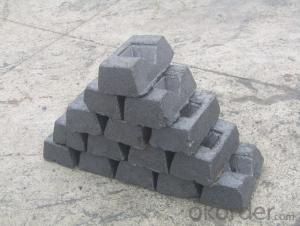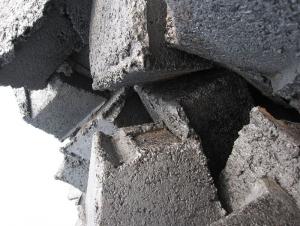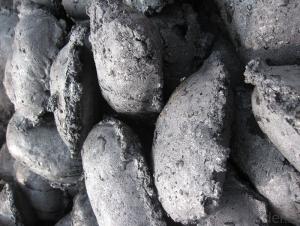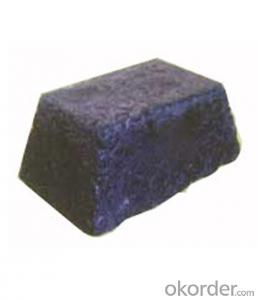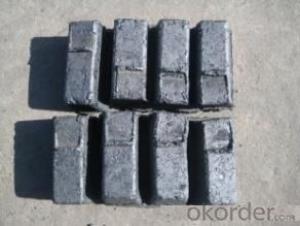Sealing Carbon Electrode Paste
- Loading Port:
- China Main Port
- Payment Terms:
- TT OR LC
- Min Order Qty:
- 20
- Supply Capability:
- 1000 /month
OKorder Service Pledge
OKorder Financial Service
You Might Also Like
Introduction:
Carbon Electrode Paste is a self-baking electrode used in submerged arc furnaces for delivering power to the charge mix. Electrode Paste is added to the top of the electrode column in either cylindrical or briquette form. As the paste moves down the electrode column the temperature increase causes the paste to melt and subsequently bake forming a block of electrically conductive carbon. Electrode Paste is essentially a mix of Electrically Calcined Anthracite (ECA) or Calcined Petroleum Coke (CPC) with Coal Tar Pitch.
•Main Function And Features
1) Low ash content
2) Good electric and thermal conductivity
3) High resistance to temperature
4) Stable quality
5) Reasonable price
6) Size:all kinds of electrode paste
7) Accord customer's reques change
Specification:
S/N | Sealing paste | Chemically Electrode Paste | |
Item | No.1 | No.2 | |
Ash.( % ) | 4.0 max | 6.0 max | 11.0 max |
V.M (%) | 12.0-15.5 | 12.0-15.5 | 11.5-15.5 |
Compress Strength. (Mpa) | 18.0 min | 17 min | 19.6 min |
Specific Resistance (μΩm) | 65 max | 7568 max | 90 max |
Bulk Density (G/CM3) | 1.38 min | 1.38 min | 1.38 min |
Elongation % | 5-20 | 5-20 | 5-25 |
PICTURE:
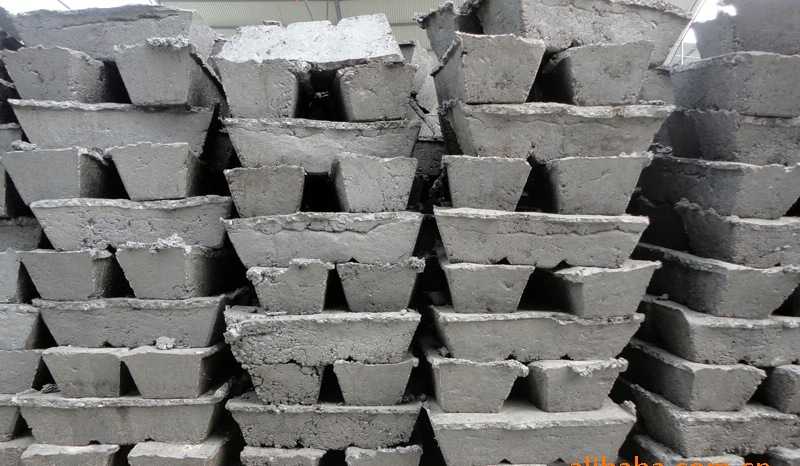
- Q: What are the impacts of carbon emissions on wildlife?
- Wildlife and their ecosystems are significantly affected by carbon emissions, which have a profound impact on their survival. The release of greenhouse gases, primarily carbon dioxide, into the atmosphere is one of the main causes of climate change, which directly affects wildlife and their habitats. One of the most immediate consequences is the alteration of habitats. The rise in temperature can result in the loss of important habitats like coral reefs, mangroves, and polar ice caps, which are home to various species. This loss can lead to the displacement or extinction of vulnerable species, disrupting entire food chains and ecological systems. Additionally, climate change has a significant influence on the timing and availability of resources for wildlife. Changes in temperature and precipitation patterns can disrupt migration, breeding, and hibernation cycles for many species. This can create mismatches between the availability of food sources and the needs of wildlife, ultimately impacting their survival and ability to reproduce. Carbon emissions also cause ocean acidification, which is detrimental to marine organisms. When carbon dioxide dissolves in seawater, it forms carbonic acid, which lowers the pH of the oceans. This acidity negatively affects marine organisms, particularly those with calcium carbonate shells or skeletons, such as corals, oysters, and certain types of plankton. This disruption in the marine food chain can have cascading effects on other marine species, including fish, birds, and marine mammals. Furthermore, carbon emissions contribute to air pollution, directly harming wildlife. Pollutants like nitrogen dioxide and sulfur dioxide can damage respiratory systems, impairing the health and reproductive success of animals. This is especially harmful to species living in or near urban areas with high pollution levels. In conclusion, carbon emissions have extensive consequences for wildlife. Climate change disrupts habitats, alters resource availability, and contributes to ocean acidification. These changes can lead to the displacement or extinction of species, disrupt entire ecosystems, and jeopardize the health and survival of wildlife. It is crucial to reduce carbon emissions and implement sustainable practices to mitigate these impacts and conserve biodiversity.
- Q: What is fullerene?
- A unique structure resembling a hollow cage or sphere is what constitutes a fullerene, a molecule composed entirely of carbon atoms. Alongside graphite and diamond, it is considered a form of carbon allotrope. The renowned and most commonly known fullerene is referred to as buckminsterfullerene or simply C60, which takes the shape of a soccer ball with 60 carbon atoms. Fullerenes come in a range of sizes, from as little as 20 carbon atoms to several hundred. They can be found naturally in soot or formed through different methods like laser ablation or chemical vapor deposition. With their distinct structure, fullerenes possess exceptional properties, such as high strength, low density, and excellent electrical and thermal conductivity. Therefore, they have found applications in various fields, including nanotechnology, electronics, medicine, and materials science.
- Q: Glucose contains resveratrol (C14H12O3) to determine the mass ratio of resveratrol and carbon dioxide of the same quality as carbon dioxide
- They are x and y, containing carbon equal, according to the mass of an element = the mass of a compound * the elementMass fractionFor C14H12O3, the carbon mass fraction is C%=12*14/ (12*14+12+16*3) *100%=73.68%For CO2, the mass fraction of carbon is 12/ (12+16*2) =27.27%There is x *73.68%=y*27.27%So there's X: y =57:154
- Q: How accurate is carbon dating?
- Carbon dating is generally considered to be a highly accurate method for determining the age of organic materials up to around 50,000 years old. However, it becomes less precise for older samples due to the decreasing amount of carbon-14 remaining. Additionally, certain factors such as contamination and environmental variations can affect the accuracy of the results.
- Q: But their chemical symbols are different, so they are different elements, different substances, but they feel the same thing... Tangled up ~!
- The difference is that one of the similarities is that the appearance is black. However, the lead section is metallic luster. Carbon density is very small, about 2G per cubic centimeter, lead density is great, the density is more than 10g per cubic centimeter. Carbon is a nonmetal that can be converted into diamond. Lead is a kind of metal. Carbon is a chemically stable substance at normal temperature. Without poison, activated carbon can be used as a gas mask. Lead is a heavy metal that is harmful to humans. The chemical properties are more lively and can be used as lead batteries. The melting point of lead is very low, only a few Baidu, and the melting point of carbon can reach more than 3000 degrees. Edison made the filament out of carbon. You know that?.
- Q: What are the consequences of increased carbon emissions on global food security?
- Increased carbon emissions have significant consequences on global food security. Firstly, rising carbon dioxide levels can lead to changes in temperature and precipitation patterns, affecting crop productivity and water availability. This can result in reduced yields, crop failures, and increased vulnerability to pests and diseases, ultimately impacting food production and availability. Furthermore, carbon emissions contribute to climate change, which exacerbates extreme weather events like droughts, floods, and heatwaves. These events can destroy crops, disrupt supply chains, and increase food prices, making it difficult for vulnerable populations to access nutritious food. Additionally, climate change may lead to the loss of arable land due to desertification, sea-level rise, or other environmental changes, further diminishing food production capacity. Moreover, carbon emissions contribute to ocean acidification, which harms marine ecosystems and disrupts the food chain. This can negatively impact fish stocks and other seafood sources, affecting the livelihoods of coastal communities who rely on fishing as a primary source of food and income. Overall, increased carbon emissions have severe consequences for global food security, threatening the stability and accessibility of food supplies both on land and in the oceans. Addressing carbon emissions and adopting sustainable practices are essential in safeguarding our food systems and ensuring the wellbeing of future generations.
- Q: Who can explain that bare feet on fire carbon don't burn feet?
- These two substances are edible, containing in the mouth is naturally very safe, plus cinnabar is red, and dissolve it in the water, this red holy water is more mysterious.From time to time to the fire scattered in the "law" law of water spray powder "and" add before have feet soaking in full dissolution of cinnabar and borax "holy water", which is on the fire and carbon between your feet to form a thin protective layer of "sand", which has scientific significance, is is that all the fairies and the real reason for lossless hair or.The world is material. A scholar once said, "what is a ghost?" Some phenomena that cannot be explained by science are ghosts in our hearts. If we can continue to search in the way of science, ghosts will leave us!
- Q: How does carbon affect the formation of blizzards?
- Carbon does not directly affect the formation of blizzards. Blizzards are primarily caused by the collision of warm and cold air masses, resulting in heavy snowfall and strong winds. However, carbon emissions and climate change can influence weather patterns, potentially leading to more intense or frequent blizzards in certain regions due to alterations in atmospheric conditions.
- Q: What does "carbon neutrality" mean?
- Carbon neutral (Carbon, Neutral)The new Oxford English dictionary published in 2006 annual vocabulary "Carbon Neutral", Chinese translated as "carbon neutral", global warming and carbon dioxide emissions are closely related, "carbon neutral" refers to the total emissions of carbon dioxide is calculated, and then put these emissions by planting digest compensation, do not give the earth additional greenhouse gas emissions (mainly including carbon dioxide, methane etc.) burden, achieve the purpose of environmental protection.
- Q: What are the economic impacts of carbon emissions?
- The economic impacts of carbon emissions are significant and wide-ranging. Carbon emissions, primarily from the burning of fossil fuels, contribute to climate change and global warming. These changes in the climate have a direct impact on various economic sectors and can lead to both short-term and long-term economic consequences. One of the most notable economic impacts of carbon emissions is the cost of dealing with the effects of climate change. Extreme weather events, such as hurricanes, floods, and droughts, become more frequent and intense as a result of carbon emissions. These events can cause extensive damage to infrastructure, homes, and businesses, leading to significant economic losses. For example, in 2017, the United States experienced a record-breaking hurricane season, with hurricanes Harvey, Irma, and Maria causing an estimated $265 billion in damages. Moreover, carbon emissions also affect agricultural productivity. Climate change alters temperature and precipitation patterns, which can disrupt crop production and decrease yields. This, in turn, affects food prices and availability, impacting both consumers and farmers. Additionally, carbon emissions contribute to the acidification of oceans, which can harm marine ecosystems and disrupt fisheries, leading to economic losses for fishing communities. Furthermore, carbon emissions have implications for public health, which can result in economic burdens. Air pollution caused by carbon emissions can lead to respiratory and cardiovascular illnesses, increasing healthcare costs and reducing workforce productivity. In addition, extreme heatwaves, exacerbated by carbon emissions, can have a detrimental impact on worker productivity and labor capacity, affecting economic output. To mitigate the economic impacts of carbon emissions, many countries have implemented policies and regulations to reduce greenhouse gas emissions. These policies often include carbon pricing mechanisms, such as carbon taxes or cap-and-trade systems, which aim to incentivize the transition to cleaner energy sources and reduce carbon emissions. While these policies may have short-term economic costs, they can also create opportunities for innovation and the development of green technologies, which can lead to long-term economic benefits. In conclusion, the economic impacts of carbon emissions are significant and multifaceted. From the costs of dealing with climate-related disasters to the effects on agriculture, public health, and productivity, carbon emissions have far-reaching consequences. Addressing these impacts through the implementation of effective climate policies is crucial to mitigate the economic risks and foster a sustainable and resilient economy.
Send your message to us
Sealing Carbon Electrode Paste
- Loading Port:
- China Main Port
- Payment Terms:
- TT OR LC
- Min Order Qty:
- 20
- Supply Capability:
- 1000 /month
OKorder Service Pledge
OKorder Financial Service
Similar products
Hot products
Hot Searches
Related keywords
